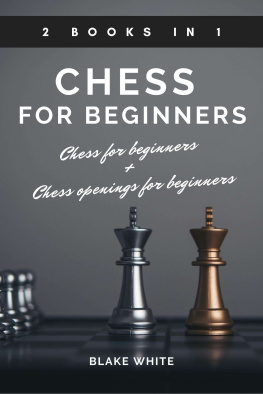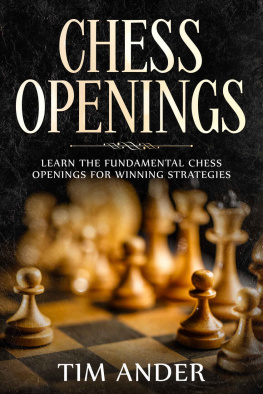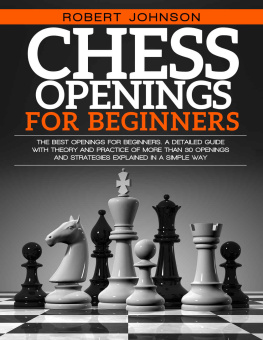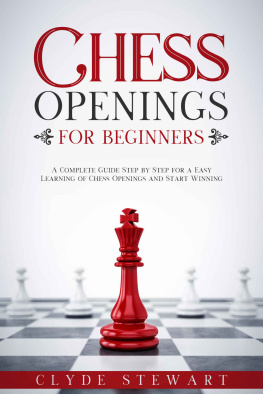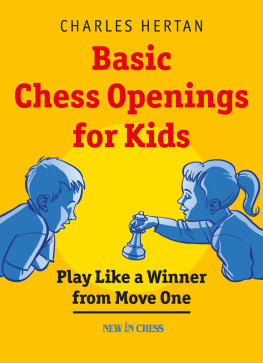White - Chess Openings For Beginners
Here you can read online White - Chess Openings For Beginners full text of the book (entire story) in english for free. Download pdf and epub, get meaning, cover and reviews about this ebook. year: 2021, genre: Children. Description of the work, (preface) as well as reviews are available. Best literature library LitArk.com created for fans of good reading and offers a wide selection of genres:
Romance novel
Science fiction
Adventure
Detective
Science
History
Home and family
Prose
Art
Politics
Computer
Non-fiction
Religion
Business
Children
Humor
Choose a favorite category and find really read worthwhile books. Enjoy immersion in the world of imagination, feel the emotions of the characters or learn something new for yourself, make an fascinating discovery.
Chess Openings For Beginners: summary, description and annotation
We offer to read an annotation, description, summary or preface (depends on what the author of the book "Chess Openings For Beginners" wrote himself). If you haven't found the necessary information about the book — write in the comments, we will try to find it.
Chess Openings For Beginners — read online for free the complete book (whole text) full work
Below is the text of the book, divided by pages. System saving the place of the last page read, allows you to conveniently read the book "Chess Openings For Beginners" online for free, without having to search again every time where you left off. Put a bookmark, and you can go to the page where you finished reading at any time.
Font size:
Interval:
Bookmark:
chess openings for beginners
The Ultimate And Definitive Guide To Learn Chess Board
Rules And Start Playing With The Best Tactics and
Efficient Strategies.
Blake White
Copyright 2020 by Blake White - All rights reserved.
The following Book is reproduced below with the goal of providing information that is as accurate and reliable as possible. Regardless, purchasing this Book can be seen as consent to the fact that both the publisher and the author of this book are in no way experts on the topics discussed within and that any recommendations or suggestions that are made herein are for entertainment purposes only. Professionals should be consulted as needed prior to undertaking any of the action endorsed herein.
This declaration is deemed fair and valid by both the American Bar Association and the Committee of Publishers Association and is legally binding throughout the United States.
Furthermore, the transmission, duplication, or reproduction of any of the following work including specific information will be considered an illegal act irrespective of if it is done electronically or in print. This extends to creating a secondary or tertiary copy of the work or a recorded copy and is only allowed with the express written consent from the Publisher. All additional right reserved.
The information in the following pages is broadly considered a truthful and accurate account of facts and as such, any inattention, use, or misuse of the information in question by the reader will render any resulting actions solely under their purview. There are no scenarios in which the publisher or the original author of this work can be in any fashion deemed liable for any hardship or damages that may befall them after undertaking information described herein.
Additionally, the information in the following pages is intended only for informational purposes and should thus be thought of as universal. As befitting its nature, it is presented without assurance regarding its prolonged validity or interim quality. Trademarks that are mentioned are done without written consent and can in no way be considered an endorsement from the trademark holder.
Table of Contents
Welcome to this book "Chess Openings for Beginners."
Chess is a game for two players that was invented in India and spread to Europe. It became an important part of the courtly culture of Europe. In the western world, chess has been prominent on college campuses and in intellectual circles years before the general public took notice.
Chess is a game divided into two distinct parts: the opening is the first phase of the chess game, and the middlegame/endgame is the second.
Chess openings are basically the first few moves of a chess game that are made by both players. Some of the chess openings are recognized to be very strong and some not so much. If a player can find a "good" chess opening then that player will possibly dominate the game. Some chess openings are very well known such as: Ruy Lopez, Kings Gambit, Sicilian Defense, and the English Opening. Many chess players find that a chess opening is a big part of the game and can be very useful.
Why are chess openings important? Because if you can get an advantage at the beginning of the game, then you will most likely end up winning.
And how do you know which chess opening is Good? There are three main things that you should look at when analyzing a chess opening. These three things are: The popularity of the opening, the percentage of wins with that opening, and what books say about it. You want to find an opening that is popular with many people but also has the highest percentage of wins for the player that uses it. Look at what books have to say about it, as Grandmasters probably know how to use that opening well. Then after finding an appropriate chess opening for yourself, try experimenting with it as much as you can so that you know how to do everything in it like: Castling, attacking pawns, defending pieces, etc.
This book Chess Openings for Beginners, talks about the chess openings: The Sicilian Defense, Ruy Lopez, Kings Gambit, English Opening, and the Slav Defense, and many more.
This book is written in a manner that a beginner would most probably understand and find useful. It also has many pages of diagrams, pictures, examples of moves, and endgames. Also, in it you will discover some of the most fascinating histories behind chess openings.
With this book you will get familiar with chess notation too: you may have heard scare stories that make chess notation extremely difficult. This complexity of chess notation is a fallacy spread by people who are too lazy to learn how simple and logical it is.
When playing chess, you must remember that the ultimate goal is to checkmate your opponents king. However, you must get past your opponents defenses before attempting this very difficult task. Therefore, it is imperative to understand the good chess openings and how to use them to your advantage!
So, shall we begin?
Chess is a fascinating board game that has challenged the imagination, creativity, and analytical prowess of people for thousands of years. Once reserved for the nobility, chess is now enjoyed by millions of people all over the world. It is a classic game between two players who have one ultimate goal in mind: to threaten the opponents king with a move that leads to an eventual capture. The road to victory, however, is usually paved with traps, decoys, and tricks. A player with adequate preparation, strategic skills, and mindset will have significant advantages over one who lacks a sound game plan and plays the game randomly.
Winning chess games consistently requires time, focus, and serious preparation. This book is designed for beginners (and advanced chess players too) who want to improve their game and take their skills to the next level.
Chess is played by two people using a chessboard with 64 squares of alternating colors eight rows and 8 columns. Each player starts with sixteen chess pieces: 8 pawns, 2 knights, 2 bishops, 2 rooks, 1 queen, and 1 king.
Here are how the chess pieces are arranged at startup:
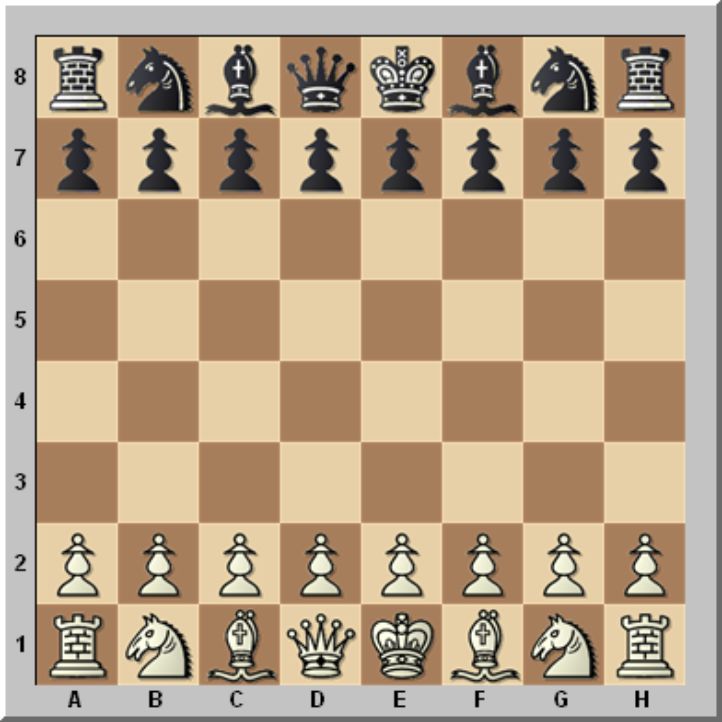
The rows are called ranks while the columns are called files.
- The pawn
The pawns are usually the first ones to go to battle. From its starting position, the pawn can move up to two squares forward. Away from its original square, it can only move one square ahead and can never go backward. It captures opposing pieces one square diagonally forward on its left or right side. The pawn may also capture the enemys pawn using the En Passant (in passing) rule.
While it has many weaknesses, a pawn is the only chessman that can be promoted. A pawn that has reached the back rank of the opponent can be exchanged for a knight, bishop, rook, or queen. There is no limit to how many pawns may be promoted.
- The knights
The knight is the only piece that can jump over other pieces. This capability allows it to be the only other piece besides a pawn that can make the initial move in a chess game. The knight moves or jumps in an L-shaped pattern - one square to its left or right and two squares forward/backward or two squares forward/backward and one square to the left or right.
- The bishops
The bishops move diagonally in any number of squares as long as it is not restricted by other pieces. Each side has two bishops at the start. One controls the light-shaded squares while the other moves along with the dark-shaded ones. The bishops cannot jump over other pieces like the knight.
Next pageFont size:
Interval:
Bookmark:
Similar books «Chess Openings For Beginners»
Look at similar books to Chess Openings For Beginners. We have selected literature similar in name and meaning in the hope of providing readers with more options to find new, interesting, not yet read works.
Discussion, reviews of the book Chess Openings For Beginners and just readers' own opinions. Leave your comments, write what you think about the work, its meaning or the main characters. Specify what exactly you liked and what you didn't like, and why you think so.








